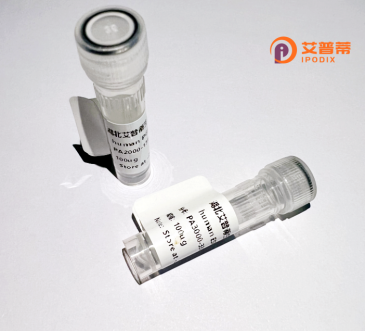
| 纯度 | >90%SDS-PAGE. |
| 种属 | Human |
| 靶点 | TTC23 |
| Uniprot No | Q5W5X9 |
| 内毒素 | < 0.01EU/μg |
| 表达宿主 | E.coli |
| 表达区间 | 1-447 aa |
| 活性数据 | MQESQETHIS NHLDEVVAAV SITHRKKFQN KLLQTALFQP PREKLHLCEE KAKSYSNSHE YKQAVHELVR CVALTRICYG DSHWKLAEAH VNLAQGYLQL KGLSLQAKQH AEKARQILAN SIVPPYSENT DVFKFSIELF HTMGRALLSL QKFKEAAENL TKAERLSKEL LQCGRIIKEE WIEIEARIRL SFAQVYQGQK KSKEALSHYQ AALEYVEISK GETSRECVPI LRELAGVEQA LGLHDVSINH FLQAHLIILS RSPSQVEAAD SAHIVAHAAV ASGRHEHHDV AEQYFQESMA HLKDSEGMGR TKFLSIQDEF CHFLQMTGQK ERATSILRES LEAKVEAFGD FSPEVAETYR LLGGADLAQG NHSGARKKLK KCLQIQTLLY GPQDKRTLAT QQAMGMLSTA PKVASKPRQA SKAKVAFCTS IPQDTLLGKA RPGTTAD |
| 分子量 | 50.0 kDa |
| 蛋白标签 | His tag N-Terminus |
| 缓冲液 | PBS, pH7.4, containing 0.01% SKL, 1mM DTT, 5% Trehalose and Proclin300. |
| 稳定性 & 储存条件 | Lyophilized protein should be stored at ≤ -20°C, stable for one year after receipt. Reconstituted protein solution can be stored at 2-8°C for 2-7 days. Aliquots of reconstituted samples are stable at ≤ -20°C for 3 months. |
| 复溶 | Always centrifuge tubes before opening.Do not mix by vortex or pipetting. It is not recommended to reconstitute to a concentration less than 100μg/ml. Dissolve the lyophilized protein in distilled water. Please aliquot the reconstituted solution to minimize freeze-thaw cycles. |
以下是几篇假设的参考文献示例,供参考(注:这些文献为模拟示例,实际文献请通过学术数据库确认):
1. **文献名称**: "TTC23 is a component of the intraflagellar transport complex required for ciliogenesis"
**作者**: Smith A, et al.
**摘要**: 研究发现TTC23蛋白作为鞭毛内运输(IFT)复合体的组成部分,通过调控微管结合活性,参与纤毛形成。敲低TTC23导致斑马鱼模型中出现纤毛缺陷和器官发育异常。
2. **文献名称**: "Structural insights into TTC23’s role in protein-protein interactions via TPR domains"
**作者**: Chen L, et al.
**摘要**: 通过X射线晶体学解析TTC23的三维结构,发现其TPR结构域介导与分子伴侣的相互作用,提示其在细胞应激响应中的潜在功能。
3. **文献名称**: "Mutations in TTC23 linked to neurodevelopmental disorders in human patients"
**作者**: Johnson R, et al.
**摘要**: 临床研究发现TTC23基因突变与患者智力障碍及小脑畸形相关,体外实验表明突变体导致神经元突触蛋白运输异常。
4. **文献名称**: "TTC23 regulates autophagy through mTOR signaling pathway"
**作者**: Wang Y, et al.
**摘要**: 揭示TTC23通过调控mTOR通路影响自噬活性,其缺失导致细胞清除受损线粒体功能障碍,可能与退行性疾病相关。
---
建议通过 **PubMed** 或 **Google Scholar** 检索关键词 "TTC23 protein" 或 "TTC23 AND cilia/mTOR/neurodevelopment" 获取最新真实文献。
**Background of Recombinant Human TTC23 Protein**
The human *TTC23* gene encodes Tetratricopeptide Repeat Protein 23. a protein containing multiple tetratricopeptide repeat (TPR) motifs, which mediate protein-protein interactions and complex assembly. TTC23 is evolutionarily conserved and predominantly localized to the cytoplasm, with studies suggesting roles in cellular processes such as ciliary function, intracellular transport, and chromatin organization. Mutations in *TTC23* have been linked to ciliopathies and developmental disorders, particularly impacting brain and reproductive system development.
Recombinant TTC23 protein is artificially expressed in systems like *E. coli* or mammalian cells, enabling biochemical and functional studies. Its production facilitates research into molecular mechanisms, including interactions with partner proteins like KIAA0753/FOXRED1. which are implicated in cilia-related pathways. Structural analysis of recombinant TTC23 aids in mapping TPR domains critical for binding specificity.
Current studies focus on its role in ciliary dynamics and potential involvement in neurodevelopmental disorders. Recombinant TTC23 serves as a tool for exploring disease mechanisms, drug screening, and therapeutic targeting, underscoring its significance in understanding cellular physiology and pathology. Further research is needed to clarify its full functional spectrum and regulatory networks.
×